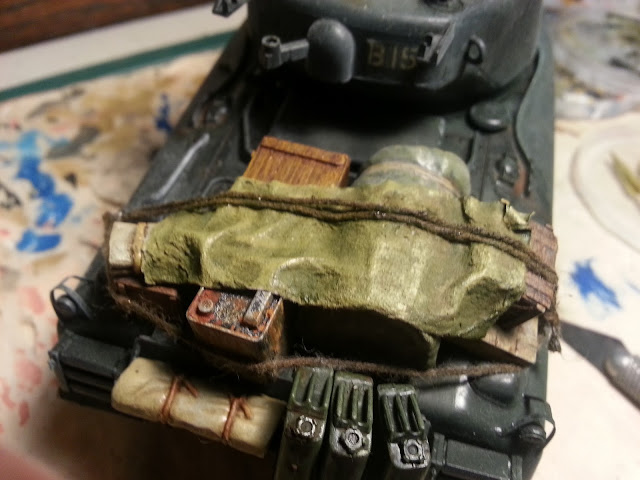I've been busy adding mud to my Sherman tank. As mentioned previously, it's a process I find nervewracking. It's a fairly organic and unpredictable process, you can really bugger up a model that was looking amazing, and it's pretty much impossible to backtrack from. So how is my effort looking?
To model mud I use my patented 3-ingredient mud technique - you can find out more about it here or you can just view the YouTube video tutorial here - it's easy and cheap, so I'm a bit of a fan.
I started tentatively - easy does it.
 |
| Yeah... nah. |
 |
| Just not enough mud. |
 |
| Not enough at all. |
I left this to dry overnight, but it just didn't look muddy enough, and the colour was a bit too monotone - there was no sense of various layers of accumulated mud. A vehicle would have dried older mud and darker, wetter looking recent mud. So tonight I went back for more.
Rookie mistake
Tonight I realised that I hadn't painted the black rubber on the road wheels. I don't know how this escaped my attention in the 8 years this baby has been sitting around partially completed... Sigh. But then I figured if I was increasing the amount of mud, this might actually save my arse - although I don't like applying mud to my models, it is just great at hiding cock-ups. [Cue evil laugh: bwahahaha!]More mud
My plan was to apply a lighter tone of mud to simulate dried older mud deposits, and then use darker, richer oil paints to make a glossier and darker layer of fresh, wetter mud. |
| The mud palette, aka an old plastic lid. This stuff is like concrete when it's set, so do this on something you are happy to throw away when you're finished. |
In this image you can see the three tones of mud. From left to right: the original tone (plain old Tamiya XF-52 Flat Earth); then the lighter tone (50% Flat Earth mixed with 50% Desert Yellow XF-59); then the wetter more recent mud (50% burnt umber and 50% VanDyke Brown artists' oils); finally, the red dish contains the garden dirt I use to give the mud texture.
And here is the end result as of this evening:
 |
| I particularly like the splattered effect above the tracks. |
It's definitely looking better than 24 hours ago. I will wait to see what it looks like tomorrow, I find the colour can change a lot as the PVA glue in the mud mixture dries. My gut feeling at the moment is that I will need to airbrush a surrounding spray of the lighter dry mud tone to make it look more like that is the bottom layer - did this a bit back-to-front, it would have been much better to apply the lighter dried mud first, then layer the others on top, as they would have actually accumulated in real life.
Like I say, this whole mud weathering malarkey is nervewracking. Hmm, maybe time to build a plane next...
Until next time,
Cheers,
Dave





































